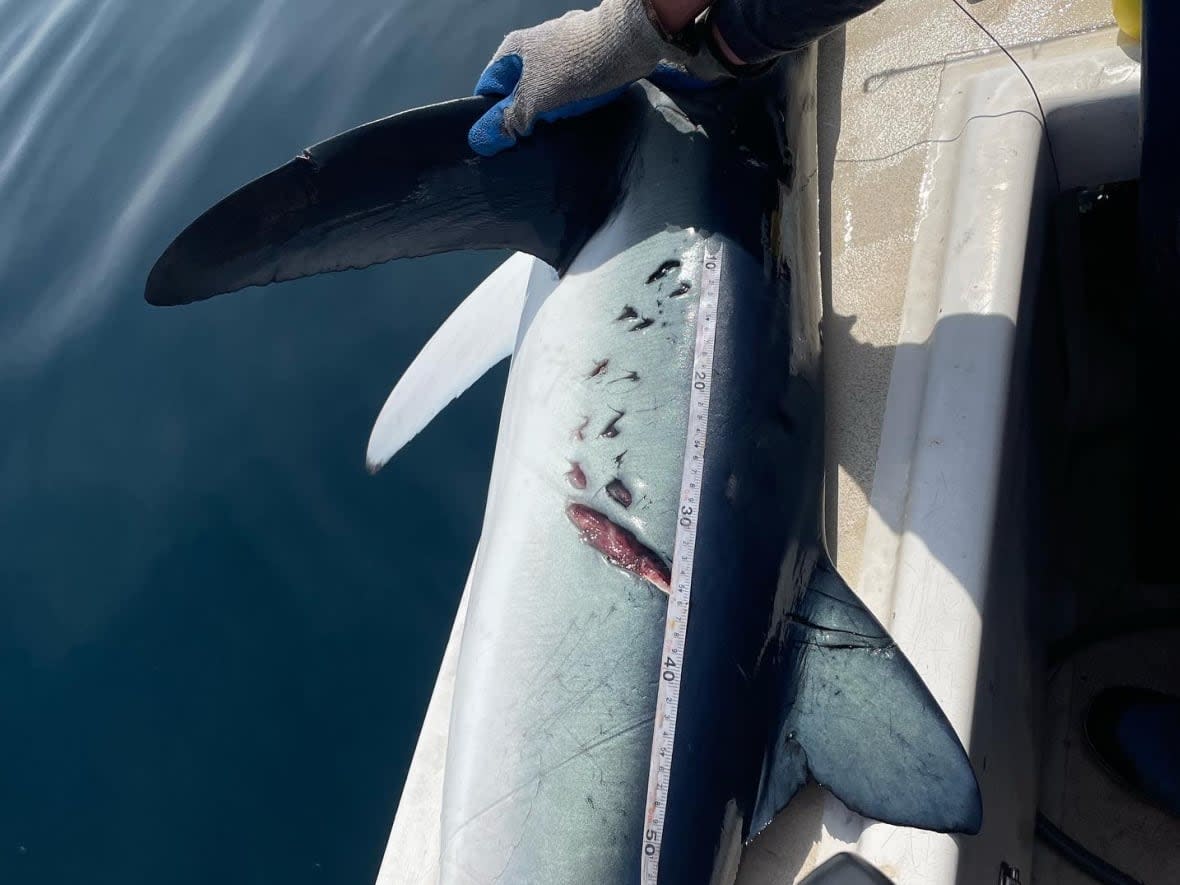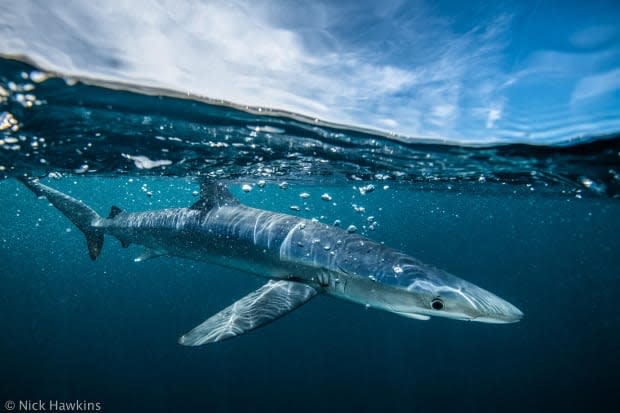Great white shark leaves its mark in shark-on-shark attack

When Charles Bangley hauled a two-metre-long blue shark on board a fishing boat off Nova Scotia's Eastern Passage in late August, he thought it was just another routine shark catch. But he was wrong. This fish was a victim of shark-on-shark violence.
"When this shark came up onto the deck, it became very apparent almost immediately that there was a big wound on the back."
Bangley is a biologist at Dalhousie University. He studies sharks, so the injured blue shark he caught wasn't in any danger — at least, not from him.

Bangley heads up the Ocean Technology project at Dalhousie. He teaches marine biology students how to tag sharks electronically so that their movements can be studied. But what he saw on this particular shark, surprised him.
"Once we had it kind of laid out on the side of the boat, where we take our measurements, things like length, and girth and all that, we could actually very clearly see this big bite mark that was on the back of the shark."
The bite was fresh, perhaps only a few hours old. Bangley asked his Dalhousie colleague Chris Harvey-Clark to examine the wound. Harvey-Clark is a marine biologist, shark expert and author of the book Maritime Marine Life.
He knew what he was looking at. "It had absolutely classic characteristic bites of a large white shark on it."
Harvey-Clark was able to use the bite mark to estimate the size of the shark. "Somewhere between 4.0 and 4.4 metres in length. So it was a good size shark. You wouldn't want to bump into the shark on a dark night."
And Harvey-Clark knows all about bumping into great white sharks. Last year, he was scuba diving in the approaches to Halifax harbour when he saw something very large swimming nearby.
"Having a four-metre-long white shark buzz you repeatedly, coming in checking you out, going away, coming back each time, circling inshore so if you were a seal your path is cut off. That's a frightening experience."
Changing seasons for white sharks
Frightening enough that Harvey-Clark admitted he's not done as much diving this year as he usually would. He's not afraid of white sharks, but he has a healthy respect for one of the ocean's top predators. And he thinks we're definitely seeing more of them in Nova Scotia's waters.
"We used to think shark season was July to September. Well, shark season is now more like June to at least November. And that was what astounded me when I encountered the shark last year. What's a white shark doing here in November? They should be heading south by now."
No one really knows how many white sharks are out there. They come here to feed on seals, and there is no shortage of food. Harvey-Clark estimates there are about 440,000 seals in the Maritimes and they produce another 87,000 seals every year. That combination of plentiful food and a warming ocean makes Nova Scotia waters more attractive to great white sharks and other shark species.

That's why shark tagging programs are so important. They expand our knowledge of where sharks live, feed and breed. And that's vital for understanding the health not just of the sharks, but also of our oceans.
That work is also carried out by another Nova Scotia-based research group, the Shark and Ray Conservation Centre, headed by another Dalhousie shark researcher, Manuel Dureuil. He compares the role of sharks in the ocean to wolves in the Yellowstone National Park. When wolves were reintroduced to the park as top predators, they helped restore balance to a damaged ecosystem.
"It's similar in our oceans," Dureuil says, "but we just don't see it. We don't see how degraded it is and we never see the important role that sharks can play in stabilizing other populations."
One thing all these shark researchers share is a passion for these ancient animals — Harvey-Clark notes they've been in our oceans for 450 million years, "that's longer than trees have been around" — and a desire to get more people to understand that sharks are not inherently dangerous, but a vital part of our underwater world.
Benefits of shark tagging for students
Manuel Dureiul says that when students take part in tagging sharks, they get the unique opportunity to actually see the animals up close.
"The shark is looking at you and you see a large, predatory, beautiful animal. You're not scared of it. You're just fascinated by it. It's unbelievable. They are such beautiful creatures."
They are also remarkably resilient. The blue shark attacked by a great white will likely recover quite quickly from the experience.

"They heal from wounds like that, and very, very quickly," Charles Bangley says. "So I would say by this time next year, you'd have some nice scarring on that shark from that bite, but it would not be anywhere near those big open wounds."
Resilient or not, the wounded shark was rejected for the tagging program. The electronic tags are inserted surgically and are expensive. The researchers felt this shark had gone through enough. It was dropped back into the ocean.
David Pate is a journalist, broadcaster and writer in Halifax. His latest project is the podcast "National Anthems: The Worst Songs in the World."
MORE TOP STORIES


